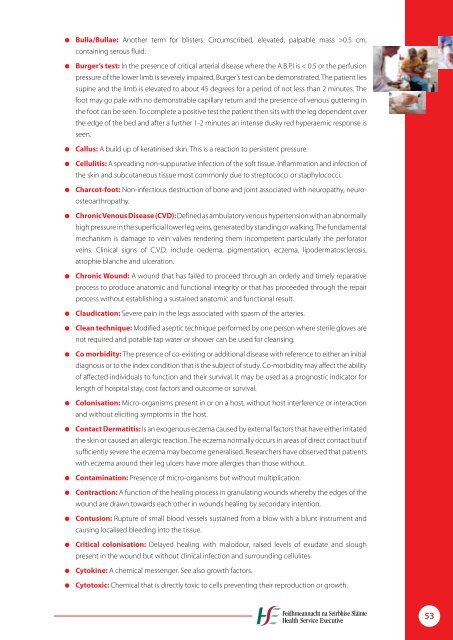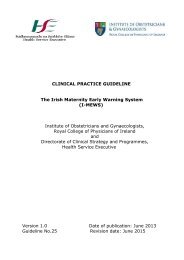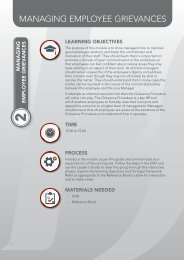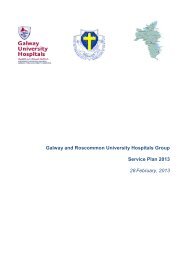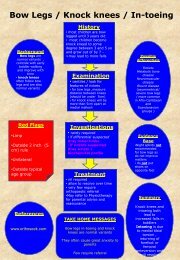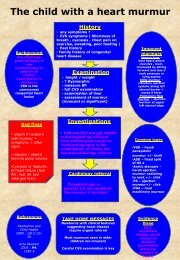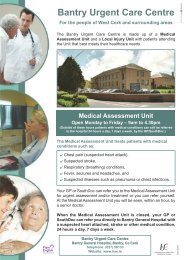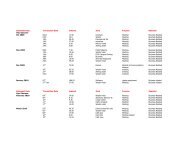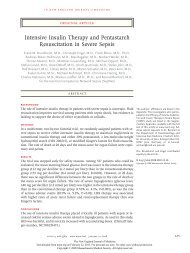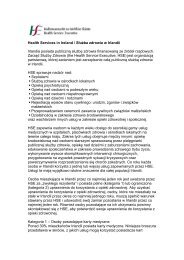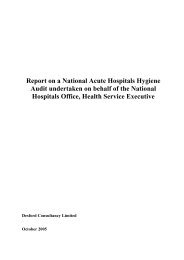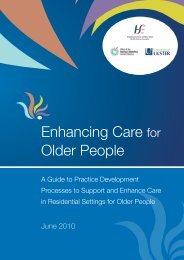National best practice and evidence based guidelines for wound ...
National best practice and evidence based guidelines for wound ...
National best practice and evidence based guidelines for wound ...
You also want an ePaper? Increase the reach of your titles
YUMPU automatically turns print PDFs into web optimized ePapers that Google loves.
● Bulla/Bullae: Another term <strong>for</strong> blisters. Circumscribed, elevated, palpable mass >0.5 cm,<br />
containing serous fluid.<br />
● Burger’s test: In the presence of critical arterial disease where the A.B.P.I is < 0.5 or the perfusion<br />
pressure of the lower limb is severely impaired, Burger’s test can be demonstrated. The patient lies<br />
supine <strong>and</strong> the limb is elevated to about 45 degrees <strong>for</strong> a period of not less than 2 minutes. The<br />
foot may go pale with no demonstrable capillary return <strong>and</strong> the presence of venous guttering in<br />
the foot can be seen. To complete a positive test the patient then sits with the leg dependent over<br />
the edge of the bed <strong>and</strong> after a further 1-2 minutes an intense dusky red hyperaemic response is<br />
seen.<br />
● Callus: A build up of keratinised skin. This is a reaction to persistent pressure.<br />
● Cellulitis: A spreading non-suppurative infection of the soft tissue. Inflammation <strong>and</strong> infection of<br />
the skin <strong>and</strong> subcutaneous tissue most commonly due to streptococci or staphylococci.<br />
● Charcot-foot: Non-infectious destruction of bone <strong>and</strong> joint associated with neuropathy, neuroosteoarthropathy.<br />
● Chronic Venous Disease (CVD): Defined as ambulatory venous hypertension with an abnormally<br />
high pressure in the superficial lower leg veins, generated by st<strong>and</strong>ing or walking. The fundamental<br />
mechanism is damage to vein valves rendering them incompetent particularly the per<strong>for</strong>ator<br />
veins. Clinical signs of C.V.D. include oedema, pigmentation, eczema, lipodermatosclerosis,<br />
atrophie blanche <strong>and</strong> ulceration.<br />
● Chronic Wound: A <strong>wound</strong> that has failed to proceed through an orderly <strong>and</strong> timely reparative<br />
process to produce anatomic <strong>and</strong> functional integrity or that has proceeded through the repair<br />
process without establishing a sustained anatomic <strong>and</strong> functional result.<br />
● Claudication: Severe pain in the legs associated with spasm of the arteries.<br />
● Clean technique: Modified aseptic technique per<strong>for</strong>med by one person where sterile gloves are<br />
not required <strong>and</strong> potable tap water or shower can be used <strong>for</strong> cleansing.<br />
● Co morbidity: The presence of co-existing or additional disease with reference to either an initial<br />
diagnosis or to the index condition that is the subject of study. Co-morbidity may affect the ability<br />
of affected individuals to function <strong>and</strong> their survival. It may be used as a prognostic indicator <strong>for</strong><br />
length of hospital stay, cost factors <strong>and</strong> outcome or survival.<br />
● Colonisation: Micro-organisms present in or on a host, without host interference or interaction<br />
<strong>and</strong> without eliciting symptoms in the host.<br />
● Contact Dermatitis: Is an exogenous eczema caused by external factors that have either irritated<br />
the skin or caused an allergic reaction. The eczema normally occurs in areas of direct contact but if<br />
sufficiently severe the eczema may become generalised. Researchers have observed that patients<br />
with eczema around their leg ulcers have more allergies than those without.<br />
● Contamination: Presence of micro-organisms but without multiplication.<br />
● Contraction: A function of the healing process in granulating <strong>wound</strong>s whereby the edges of the<br />
<strong>wound</strong> are drawn towards each other in <strong>wound</strong>s healing by secondary intention.<br />
● Contusion: Rupture of small blood vessels sustained from a blow with a blunt instrument <strong>and</strong><br />
causing localised bleeding into the tissue.<br />
● Critical colonisation: Delayed healing with malodour, raised levels of exudate <strong>and</strong> slough<br />
present in the <strong>wound</strong> but without clinical infection <strong>and</strong> surrounding cellulites.<br />
● Cytokine: A chemical messenger. See also growth factors.<br />
● Cytotoxic: Chemical that is directly toxic to cells preventing their reproduction or growth.<br />
53


